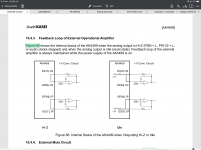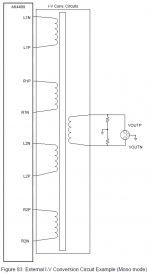Hi - I have been reading this thread with great interest.
Your transformers sound excellent.
What transformer would you recommend for the new AK4499 - 1:4 ?
The output current is rather high at 72ma.
Your transformers sound excellent.
What transformer would you recommend for the new AK4499 - 1:4 ?
The output current is rather high at 72ma.
Hi!
72mA is 4 times more than cores (which I am using now) can handle. 72mA of output current according to my understanding should require revising the separation between sources (preamplifiers\dacs\players\etc.) and power amplifiers (high-current devices). In other case I do not really see the benefits of using such a device for regular usage as regular DAC. I remember complaints from engeniers even to 16mA of output current from ES9018S because it was hard to implement the I/V stage in this case... And now fantastic 72mA comes! Anyway it is possible to make transformer for 72mA, but will the 4499 be really so popular\better for their owners to wish invest up to 4 time more money into i/v transformer? I think it is better to wait for the first impressions from first users...
72mA is 4 times more than cores (which I am using now) can handle. 72mA of output current according to my understanding should require revising the separation between sources (preamplifiers\dacs\players\etc.) and power amplifiers (high-current devices). In other case I do not really see the benefits of using such a device for regular usage as regular DAC. I remember complaints from engeniers even to 16mA of output current from ES9018S because it was hard to implement the I/V stage in this case... And now fantastic 72mA comes! Anyway it is possible to make transformer for 72mA, but will the 4499 be really so popular\better for their owners to wish invest up to 4 time more money into i/v transformer? I think it is better to wait for the first impressions from first users...
Hi,
Thanks for your fast response.
Yes agreed 72ma is a massive amount.
I will be running the DAC in software mode so I can reduce the current.
Maybe down to 22 ma so do you think that would be suitable with your current transformers?
Thanks for your fast response.
Yes agreed 72ma is a massive amount.
I will be running the DAC in software mode so I can reduce the current.
Maybe down to 22 ma so do you think that would be suitable with your current transformers?
Do you have 4499 evaluation board already? 22mA should be ok, I think. But is there any DC Voltage between IOUTL1N and IOTL1P?
I have my own prototype board so I will check for a voltage differential between those pins.
Thanks.
Thanks.
Please make the measurement during silence-file playing, because any DC-presence at pause is not very interested (it can vary and will not make any affect to the core, because there is no memory-effect in such core material). In case of AK4490 DC can be only without signal between OUT+\OUT-.
Guys,
When designing trafos for ak4499 keep in my what Taramoto found for es9038pro chip:
Teramoto FINEMET Multi tap Premium Transformer ES9038 Pro DAC (2+2+2+2 : 1+1) | eBay
They found out that is better to do the summing on the output of transformer, rather than summing them at dac level and the using transformer with one pair of input.
Now, since ak4499 has 4 pairs of outputs (2 pairs per one channel) then trafo should have 2 pairs of input and one output and the same for second channel.
When designing trafos for ak4499 keep in my what Taramoto found for es9038pro chip:
Teramoto FINEMET Multi tap Premium Transformer ES9038 Pro DAC (2+2+2+2 : 1+1) | eBay
They found out that is better to do the summing on the output of transformer, rather than summing them at dac level and the using transformer with one pair of input.
Now, since ak4499 has 4 pairs of outputs (2 pairs per one channel) then trafo should have 2 pairs of input and one output and the same for second channel.
It is a good idea, agree. But why I do not remember the similar findings from Ian for his dual mono ES9038q2m DAC?..
It is a good idea, agree. But why I do not remember the similar findings from Ian for his dual mono ES9038q2m DAC?..
I don't remember anyone trying it yet. Ian's dac hasn't been out that long, and I think most that use transformers are using Ian's recommended lundahl one.
It is a good idea, agree. But why I do not remember the similar findings from Ian for his dual mono ES9038q2m DAC?..
Well good point. Ian would have to redesign his dac and allow to do that. Currently outputs are merged from each chip.
Once done, Ian could write thd compensation programme for your trafos as an option 🙂 That would be fun!
Last edited:
I don't remember anyone trying it yet. Ian's dac hasn't been out that long, and I think most that use transformers are using Ian's recommended lundahl one.
Sure, not long. But LL1544A and 1674 or 1684 have enough coils to make such conections. I think simply there was no tests for using paralleled DACs in such conection. Or vise versa it was done with OpAmps previously without any benefits and forgotten...
Hi Guys,
I'm just playing around with my AK4499 test board & wondering if using dual primary windings is the best way to combine channels in a dual mono setup.
The AK4499 is like two stereo DAC's so in the registry settings it is possible to set each
stereo DAC to a single channel & nominate whether it is left or right.
AKM recommends summing channels after the op amp I/V but I want to use bisesik's nice transformers & with dual primary windings it would be another simple option.
I just did a quick test using a 150 ohm to 600 ohm (dual primary) OEP transformer & it seems to work fine but its hard to gauge the sound quality on my basic test board.
Thoughts anyone?
I'm just playing around with my AK4499 test board & wondering if using dual primary windings is the best way to combine channels in a dual mono setup.
The AK4499 is like two stereo DAC's so in the registry settings it is possible to set each
stereo DAC to a single channel & nominate whether it is left or right.
AKM recommends summing channels after the op amp I/V but I want to use bisesik's nice transformers & with dual primary windings it would be another simple option.
I just did a quick test using a 150 ohm to 600 ohm (dual primary) OEP transformer & it seems to work fine but its hard to gauge the sound quality on my basic test board.
Thoughts anyone?
Here I asked for Ian about outputs merging:
And he answered:bisesik said:Have you tried earlier not to merge 2 outputs of one ES9038q2m (for dual mono version) before the transformer to allow transformer to do this job itself? I mean the connection:
DACR+DACRB->Prim.coil#1 of transformer
DACL+DACLB->Prim.coli#2 of transformer
iancanada said:I did. But using all outputs in SE mode to transformer coils will need audio capacitors for each output. For me, balanced configuration sounds better. But I could be wrong.
Can you point to this mention? Datasheet?AKM recommends summing channels after the op amp I/V ...
If you talking about point 10.4.2. External Analog low Pass Filter Example and quote from there: Differential voltage signal after I-V conversion is summed by differential summing circuit...
Then it is not about merging 2 outputs into one. It is about getting SE from differential output. I think it can be easily done by one coil.
Last edited:
Just checked Ian's board under a magnifying glass 😀 There are direct connections DACR+DACL and DACRB+DACLB directly by traces from pin 3 to 8 and from 2 to 9 on both chips. So I will try to find way for upgrading it and to break DACL\DACR and DACLB\DACRB connections for use with dual primary coils.
Last edited:
Regarding mono mode & combining all four channels to a single (still balanced) output
See Figure 83 in the data sheet.
All four channels use the normal op amp I/V stage & then the outputs are all connected in
parallel via resistors.
See Figure 83 in the data sheet.
All four channels use the normal op amp I/V stage & then the outputs are all connected in
parallel via resistors.
Regarding mono mode & combining all four channels to a single (still balanced) output
See Figure 83 in the data sheet.
All four channels use the normal op amp I/V stage & then the outputs are all connected in
parallel via resistors.
Found it, thx! Yes, that is it, right.
- Home
- Vendor's Bazaar
- Output transformers for DACs

